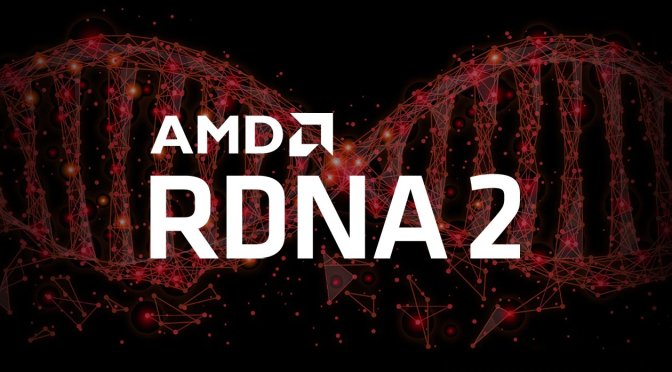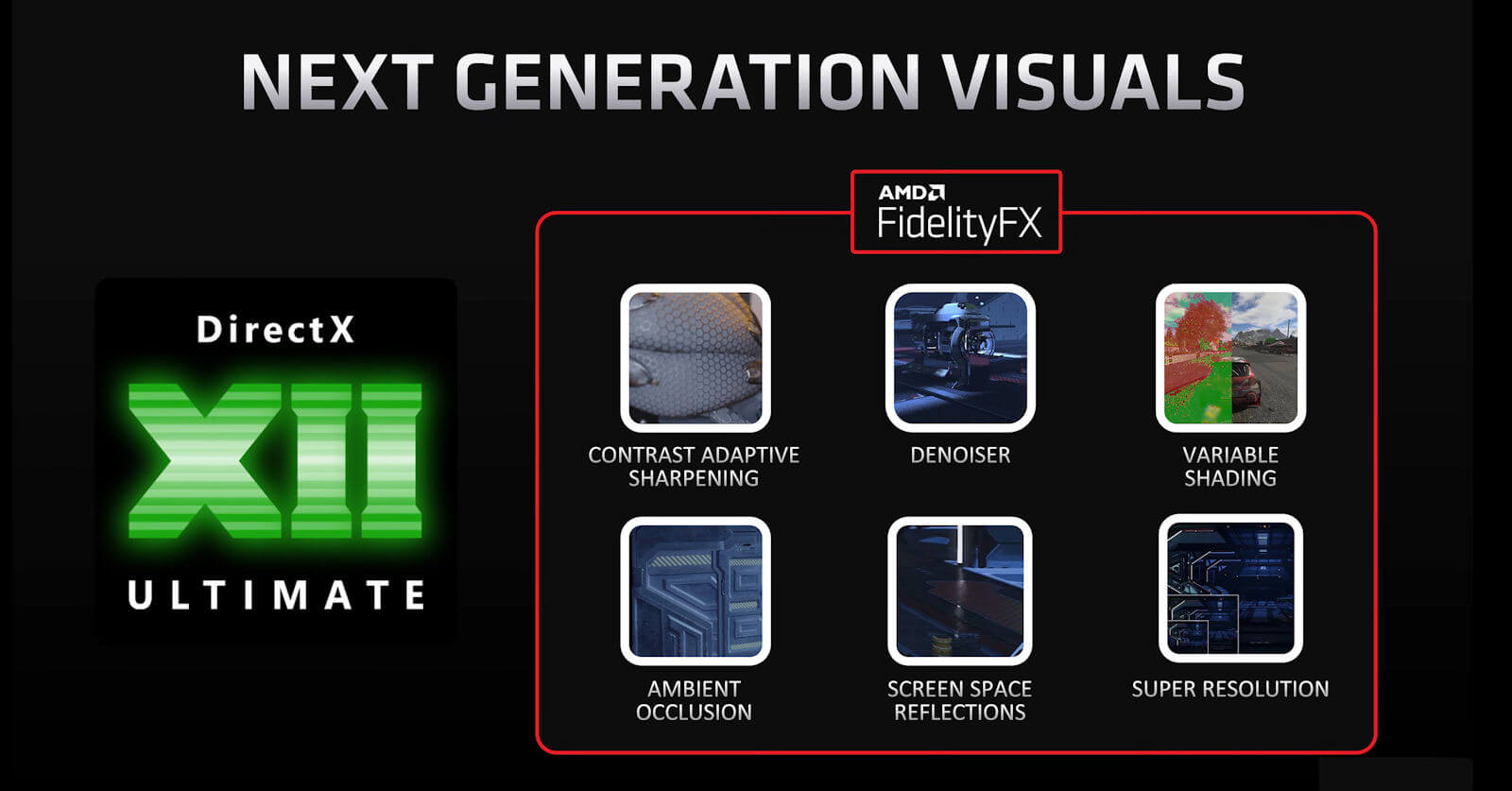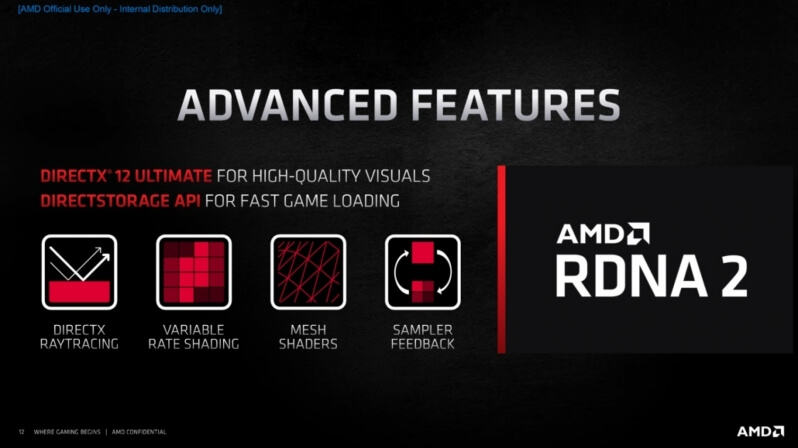Just a few days ago AMD officially announced its RDNA 2-based flagship Big Navi graphics cards, the Radeon RX 6900XT, RX 6800XT and RX 6800, respectively. The Red team introduced three graphics cards based on RDNA 2 GPU architecture with prices ranging from 579 to 999 USD. AMD will be competing with NVIDIA, and directly targeting each of the RTX 30 series Ampere-based SKUs.
Even though the RDNA 2 Live event showcased benchmarks that favored the Radeon RX 6900 XT, Radeon RX 6800 XT, and Radeon RX 6800 over the competition, none of them included metrics related to ray tracing.
A lot of gamers have been waiting to hear about AMD’s approach to Ray Tracing and super sampling tech, similar to what Nvidia is using on its Ampere and Turing lineup of cards. It appears that AMD is indeed working on its own implementation of super sampling similar to NVIDIA’s DLSS technology.
AMD’s Frank Azor just confirmed on Twitter that AMD will provide more information about ray tracing and super sampling tech before the launch date of the upcoming Radeon RX 6000-series cards.
https://twitter.com/Rafscotti1/status/1321793656664297474
AMD is currently working on a similar solution based on Microsoft’s DirectML tech, which might land up in future PC titles, and will be part of the FidelityFX software suit. AMD’s super-sampling technique is likely to be based on DirectML, which is open source and cross-platform, and the next-gen Gaming consoles are also going to leverage this feature.
Both the PS5 and XBOX S/X consoles are based on the RDNA 2 architecture. Nvidia has been using RTX and DLSS for quite some time, and it required constant Game developer implementation, before we could see this tech in PC games. The list of supported games has surely increased over the past 2 years or so, but the adoption rate is still limited.
We all know by now how Nvidia’s DLSS tech works, and recently at the AMD Radeon RX 6000 live announcement event, Scott Herkelman hinted at a similar feature:
“We are always looking to help developers with new initiatives and we are already working on a super-resolution feature to give gamers an option for more performance when using ray tracing.”
The Verge’s Tom Warren also received more information on this super-resolution technology:
“While AMD is promising to go head to head with Nvidia in 4K gaming and more, the one big missing piece of this battle is a lack of an equivalent to Nvidia’s DLSS. Nvidia’s AI-powered super sampling technology has been transformative for the games that support it, bringing great image quality and higher frame rates by simply toggling a game setting.
AMD tells me it has a new super sampling feature in testing, which is designed to increase performance during ray tracing. The company is promising its super sampling technology will be open and cross-platform, which means it could come to next-gen consoles like the Xbox Series X and PS5. AMD is working with a number of partners on this technology, and it’s expecting strong industry support. Unfortunately, this won’t be ready for the launch of these three new Radeon RX 6000 Series cards.”
The good news here is that AMD plans to share technical details on these technologies very soon, as confirmed by Frank Azor on Twitter. Expect more info on AMD’s implementation of Ray tracing and super-resolution tech before November 18th.
Back in GDC 2019, Microsoft already gave us a glimpse of this DirectML super-resolution feature by up-scaling a 540p image to 1080p, and then a 1080p image to 4K. When tested on an NVIDIA GeForce RTX 2080 Ti GPU, DirectML allowed for a low latency of 15 ms for a 540p to 1080p upscale with high frame rates up to 67 fps, as compared to the original TensorFlow model that had a 55 ms latency and ran at 18 fps.
This is kind of outdated news. But speaking of these new technologies, few years ago AMD claimed that all of its current DX12 graphics cards support ray tracing via Microsoft’s DXR fallback layer. On the driver level, the support will be there. But, this Fallback layer is just an emulation layer provided by MS, which is capable of running on any “D3D12” compatible GPU.
It was originally meant so that the developers can learn the API (with having obvious DXR compatibility), and it was hardly intended to be able to run any games as such.
Once Ray Tracing Turing Hardware came out in the market, its development was kind of halted, as it was deemed unnecessary. That it is technically supported was never in question, the question is how fast they can do it and my guess is not very fast, otherwise they would’ve already talked about it and showed more examples by now.
But AMD was still free to provide DXR support through their D3D12 drivers though. Any D3D12 GPU is actually capable of running this DXR code, since it is just an extension of DirectCompute.
Slow Performance remains a totally different issue though (imagine running the same operations on a GPU without specialized processors/cores). But as per one recent post, the fallback layer isn’t maintained anymore and it’s unlikely that developers will use the codebase for ray tracing support under GPUs which don’t support DXR directly.
Moreover, DXR has never been an NVIDIA-exclusive thing. Every DX12-capable card can access and use it; it’s just slow (depending on the Hardware/GPU model).
Performance, however, appears to be underwhelming via this “emulation/software” method. This could explain why AMD did not properly enable the real-time ray tracing fallback layer on its drivers, as its GPUs currently lack hardware components that could accelerate the ray tracing calculations. But with the Big Navi RDNA 2 GPU lineup, AMD is taking a different approach.
In case you didn’t know, AMD Radeon RX 6000 series also feature Ray Accelerators. One official slide elaborates on the hardware component that Radeon RX 6000 Series GPUs leverage for ray tracing – the Ray Accelerator (RA). Each Compute Unit carries one Accelerator as shown below:
These RA units are responsible for the hardware acceleration of ray tracing in games. The RX 6900 XT features 80 RAs, RX 6800 XT features 72, and RX 6800 has 60. The same Ray Accelerators can be found in RDNA2-based next-gen gaming consoles.
“New to the AMD RDNA 2 compute unit is the implementation of a high-performance ray tracing acceleration architecture known as the Ray Accelerator,” a description reads. “The Ray Accelerator is specialized hardware that handles the intersection of rays providing an order of magnitude increase in intersection performance compared to a software implementation.” via AMD.
AMD will launch the Radeon RX 6800 and RX 6800 XT series of graphics cards on November 18th. The AMD Radeon RX 6900 XT flagship card will be available on December 8th and will cost around $999 USD.
Stay tuned for more!
Hello, my name is NICK Richardson. I’m an avid PC and tech fan since the good old days of RIVA TNT2, and 3DFX interactive “Voodoo” gaming cards. I love playing mostly First-person shooters, and I’m a die-hard fan of this FPS genre, since the good ‘old Doom and Wolfenstein days.
MUSIC has always been my passion/roots, but I started gaming “casually” when I was young on Nvidia’s GeForce3 series of cards. I’m by no means an avid or a hardcore gamer though, but I just love stuff related to the PC, Games, and technology in general. I’ve been involved with many indie Metal bands worldwide, and have helped them promote their albums in record labels. I’m a very broad-minded down to earth guy. MUSIC is my inner expression, and soul.
Contact: Email




